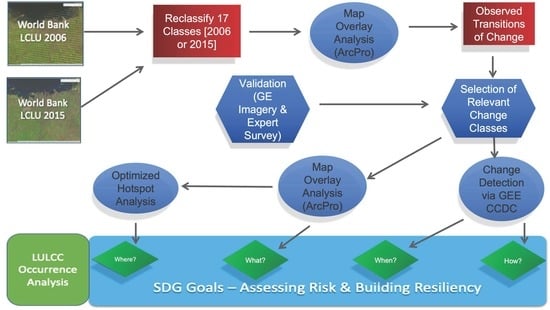Analysis of Land Use and Land Cover Changes through the Lens of SDGs in Semarang, Indonesia
Abstract
:1. Introduction
1.1. Sustainable Developement Goals
1.2. Study Area: Semarang City in Indonesia
1.3. Geospatial Data for Monitoring LULCC
2. Materials and Methods
2.1. Classifying LULCC
2.2. Identifying Significant Change Classes Using Map Overlay
2.3. Filtering LULCC Classes Using Map Overlay
2.4. Optimized Hotspot Analysis
2.5. Continuous Change Detection and Classification (CCDC)
3. Results
4. Discussion
4.1. Implication of Increased Rubber Plantations
4.2. Spread of Urban Sprawl
4.3. Relevance of Processed LULC Dataset
4.4. UN SDG Policy Possibilites
4.5. Conflicting SDGs
4.6. Implications and Future Studies
5. Conclusions
Author Contributions
Funding
Institutional Review Board Statement
Informed Consent Statement
Data Availability Statement
Conflicts of Interest
References
- Newman, J.A.; Meyer, W.B.; Ii, B.L.T. Changes in Land Use and Land Cover: A Global Perspective. Bull. Torrey Bot. Club 1995, 122, 248. [Google Scholar] [CrossRef]
- Meyer, W.B.; Turner, B.L. Human Population Growth and Global Land-Use/Cover Change. Annu. Rev. Ecol. Syst. 1992, 23, 39–61. [Google Scholar] [CrossRef]
- Foley, J.A.; Defries, R.; Asner, G.P.; Barford, C.; Bonan, G.; Carpenter, S.R.; Chapin, F.S.; Coe, M.T.; Daily, G.C.; Gibbs, H.K.; et al. Global Consequences of Land Use. Science 2005, 309, 570–574. [Google Scholar] [CrossRef] [PubMed] [Green Version]
- Song, X.-P.; Hansen, M.C.; Stehman, S.V.; Potapov, P.V.; Tyukavina, A.; Vermote, E.F.; Townshend, J.R. Global Land Change from 1982 to 2016. Nature 2018, 560, 639–643. [Google Scholar] [CrossRef] [PubMed]
- Chen, W.; Chi, G.; Li, J. The Spatial Association of Ecosystem Services with Land Use and Land Cover Change at the County Level in China, 1995–2015. Sci. Total Environ. 2019, 669, 459–470. [Google Scholar] [CrossRef]
- Henderson-Sellers, A.; Dickinson, R.E.; Durbidge, T.B.; Kennedy, P.J.; McGuffie, K.; Pitman, A.J. Tropical Deforestation: Modeling Local- to Regional-Scale Climate Change. J. Geophys. Res. Atmos. 1993, 98, 7289–7315. [Google Scholar] [CrossRef]
- Woodwell, G.M.; Hobbie, J.E.; Houghton, R.A.; Melillo, J.M.; Moore, B.; Peterson, B.J.; Shaver, G.R. Global Deforestation: Contribution to Atmospheric Carbon Dioxide. Science 1983, 222, 1081–1086. [Google Scholar] [CrossRef]
- DeFries, R.S.; Rudel, T.; Uriarte, M.; Hansen, M. Deforestation Driven by Urban Population Growth and Agricultural Trade in the Twenty-First Century. Nat. Geosci. 2010, 3, 178–181. [Google Scholar] [CrossRef]
- Winkler, K.; Fuchs, R.; Rounsevell, M.; Herold, M. Global Land Use Changes Are Four Times Greater than Previously Estimated. Nat. Commun. 2021, 12, 2501. [Google Scholar] [CrossRef]
- Liu, W.; Zhan, J.; Zhao, F.; Yan, H.; Zhang, F.; Wei, X. Impacts of Urbanization-Induced Land-Use Changes on Ecosystem Services: A Case Study of the Pearl River Delta Metropolitan Region, China. Ecol. Indic. 2018, 98, 228–238. [Google Scholar] [CrossRef]
- Climate Change 2022: Impacts, Adaptation and Vulnerability. Available online: https://www.ipcc.ch/report/ar6/wg2/ (accessed on 26 May 2022).
- Geist, H.; McConnell, W.; Lambin, E.F.; Moran, E.; Alves, D.; Rudel, T. Causes and Trajectories of Land-Use/Cover Change. In Land-Use and Land-Cover Change; Lambin, E.F., Geist, H., Eds.; Global Change—The IGBP Series; Springer: Berlin/Heidelberg, Germany, 2006; pp. 41–70. ISBN 978-3-540-32201-6. [Google Scholar]
- Xu, X.; Xie, Y.; Qi, K.; Luo, Z.; Wang, X. Detecting the Response of Bird Communities and Biodiversity to Habitat Loss and Fragmentation Due to Urbanization. Sci. Total Environ. 2018, 624, 1561–1576. [Google Scholar] [CrossRef] [PubMed]
- Macedo, M.N.; DeFries, R.S.; Morton, D.C.; Stickler, C.M.; Galford, G.L.; Shimabukuro, Y.E. Decoupling of Deforestation and Soy Production in the Southern Amazon during the Late 2000s. Proc. Natl. Acad. Sci. USA 2012, 109, 1341–1346. [Google Scholar] [CrossRef] [PubMed] [Green Version]
- Mann, M.; Kaufmann, R.; Bauer, D.; Gopal, S.; Baldwin, J.; Vera-Diaz, M.D.C. Ecosystem Service Value and Agricultural Conversion in the Amazon: Implications for Policy Intervention. Environ. Resour. Econ. 2012, 53, 279–295. [Google Scholar] [CrossRef]
- Morton, D.C.; DeFries, R.S.; Shimabukuro, Y.E.; Anderson, L.O.; Arai, E.; Del Bon Espirito-Santo, F.; Freitas, R.; Morisette, J. Cropland Expansion Changes Deforestation Dynamics in the Southern Brazilian Amazon. Proc. Natl. Acad. Sci. USA 2006, 103, 14637–14641. [Google Scholar] [CrossRef] [PubMed] [Green Version]
- Velastegui-Montoya, A.; Lima, A.D.; Adami, M. Multitemporal Analysis of Deforestation in Response to the Construction of the Tucuruí Dam. ISPRS Int. J. Geo-Inf. 2020, 9, 583. [Google Scholar] [CrossRef]
- Perz, S.; Shenkin, A.; Rondon, X.; Qiu, Y. Infrastructure Upgrades and Rural–Urban Connectivity: Distance Disparities in a Tri-National Frontier in the Amazon. Prof. Geogr. 2012, 65, 103–115. [Google Scholar] [CrossRef]
- Arias, M.E.; Piman, T.; Lauri, H.; Cochrane, T.A.; Kummu, M. Dams on Mekong Tributaries as Significant Contributors of Hydrological Alterations to the Tonle Sap Floodplain in Cambodia. Hydrol. Earth Syst. Sci. 2014, 18, 5303–5315. [Google Scholar] [CrossRef] [Green Version]
- Mustard, J.F.; Defries, R.S.; Fisher, T.; Moran, E. Land-Use and Land-Cover Change Pathways and Impacts. In Land Change Science: Observing, Monitoring and Understanding Trajectories of Change on the Earth’s Surface; Gutman, G., Janetos, A.C., Justice, C.O., Moran, E.F., Mustard, J.F., Rindfuss, R.R., Skole, D., Turner, B.L., Cochrane, M.A., Eds.; Remote Sensing and Digital Image Processing; Springer: Dordrecht, The Netherlands, 2004; pp. 411–429. ISBN 978-1-4020-2562-4. [Google Scholar]
- Haines-Young, R. Land Use and Biodiversity Relationships. Land Use Policy 2009, 26, S178–S186. [Google Scholar] [CrossRef]
- Yang, H.; Simmons, B.A.; Ray, R.; Nolte, C.; Gopal, S.; Ma, Y.; Ma, X.; Gallagher, K.P. Risks to Global Biodiversity and Indigenous Lands from China’s Overseas Development Finance. Nat. Ecol. Evol. 2021, 5, 1520–1529. [Google Scholar] [CrossRef]
- Measey, M. Indonesia: A Vulnerable Country in the Face of Climate Change. Glob. Major. E-J. 2010, 1, 31–45. [Google Scholar]
- Triana, K.; Wahyudi, A.J. Sea Level Rise in Indonesia: The Drivers and the Combined Impacts from Land Subsidence. ASEAN J. Sci. Technol. Dev. 2020, 37, 115–121. [Google Scholar] [CrossRef]
- Abidin, H.; Andreas, H.; Gumilar, I.; Fukuda, Y.; Pohan, Y.; Deguchi, T. Land Subsidence of Jakarta (Indonesia) and Its Relation with Urban Development. Nat. Hazards 2011, 59, 1753–1771. [Google Scholar] [CrossRef]
- Rimba, A.B.; Osawa, T.; Parwata, I.N.S.; As-syakur, A.R.; Kasim, F.; Astarini, I.A. Physical Assessment of Coastal Vulnerability under Enhanced Land Subsidence in Semarang, Indonesia, Using Multi-Sensor Satellite Data. Adv. Space Res. 2018, 61, 2159–2179. [Google Scholar] [CrossRef]
- Chaussard, E.; Amelung, F.; Abidin, H.Z.; Hong, S.-H. Sinking Cities in Indonesia: ALOS PALSAR Detects Rapid Subsidence Due to Groundwater and Gas Extraction. Remote Sens. Environ. 2013, 128, 150–161. [Google Scholar] [CrossRef]
- Paddock, R.C.; Suhartono, M. Indonesia’s Capital Is Sinking, Polluted and Crowded. Its Leader Wants to Build a New One. The New York Times. 2019. Available online: https://www.nytimes.com/2019/08/26/world/asia/indonesia-capital-jakarta-borneo.html (accessed on 2 March 2022).
- World Bank Group; Asian Development Bank. Climate Risk Country Profile: Indonesia; World Bank: Washington, DC, USA, 2021. [Google Scholar]
- Indonesia—Urbanization 2010–2020. Available online: https://www.statista.com/statistics/455835/urbanization-in-indonesia/ (accessed on 18 January 2022).
- Population of Indonesia—Demographic Composition Indonesia Investments. Available online: https://www.indonesia-investments.com/culture/population/item67 (accessed on 18 January 2022).
- Aspiring Indonesia: Expanding the Middle Class. Available online: https://www.worldbank.org/en/country/indonesia/publication/aspiring-indonesia-expanding-the-middle-class (accessed on 29 May 2022).
- Irfany, M.I.; Klasen, S. Affluence and Emission Tradeoffs: Evidence from Indonesian Households’ Carbon Footprint. Environ. Dev. Econ. 2017, 22, 546–570. [Google Scholar] [CrossRef] [Green Version]
- Mcgee, T. The Emergence of Desakota Regions in Asia: Expanding a Hypothesis. 1991. Available online: https://www.degruyter.com/document/doi/10.1515/9783868598933-010/html (accessed on 2 March 2022).
- McGee, T.G. Reconstructing ‘the Southeast Asian City’in an Era of Volatile Globalization. In Critical Reflections on Cities in Southeast Asia; Brill: Leiden, The Netherlands, 2002; pp. 31–53. [Google Scholar]
- Bou Dib, J.; Krishna, V.; Alamsyah, Z.; Qaim, M. Land-Use Change and Livelihoods of Non-Farm Households: The Role of Income from Employment in Oil Palm and Rubber in Rural Indonesia; University of Goettingen, Collaborative Research Centre 990 “EFForTS, Ecological and Socioeconomic Functions of Tropical Lowland Rainforest Transformation Systems”: Sumatra, Indonesia, 2018. [Google Scholar]
- Brancalion, P.H.S.; Holl, K.D. Guidance for Successful Tree Planting Initiatives. J. Appl. Ecol. 2020, 57, 2349–2361. [Google Scholar] [CrossRef]
- Transforming Our World: The 2030 Agenda for Sustainable Development: Sustainable Development Knowledge Platform. Available online: https://sustainabledevelopment.un.org/post2015/transformingourworld/publication (accessed on 18 January 2022).
- Salim, W.; Hudalah, D. Urban Governance Challenges and Reforms in Indonesia: Towards a New Urban Agenda. In New Urban Agenda in Asia-Pacific: Governance for Sustainable and Inclusive Cities; Dahiya, B., Das, A., Eds.; Advances in 21st Century Human Settlements; Springer: Singapore, 2020; pp. 163–181. ISBN 9789811367090. [Google Scholar]
- Putra, M.P.I.F.; Pradhan, P.; Kropp, J.P. A Systematic Analysis of Water-Energy-Food Security Nexus: A South Asian Case Study. Sci. Total Environ. 2020, 728, 138451. [Google Scholar] [CrossRef]
- Rahman, S.A.; Baral, H.; Sharma, R.; Samsudin, Y.B.; Meyer, M.; Lo, M.; Artati, Y.; Simamora, T.I.; Andini, S.; Leksono, B.; et al. Integrating Bioenergy and Food Production on Degraded Landscapes in Indonesia for Improved Socioeconomic and Environmental Outcomes. Food Energy Secur. 2019, 8, e00165. [Google Scholar] [CrossRef]
- World Population Prospects—Population Division—United Nations. Available online: https://population.un.org/wpp/ (accessed on 18 January 2022).
- GNI, Atlas Method (Current US$)—Indonesia|Data. Available online: https://data.worldbank.org/indicator/NY.GNP.ATLS.CD?locations=ID (accessed on 18 January 2022).
- Semarang, P.K. Resilient Semarang: Moving Together towards a Resilient Semarang; Pemerintah Kota Semarang: Semarang, Indonesia, 2016. [Google Scholar]
- Sarzynski, T.; Giam, X.; Carrasco, L.; Lee, J.S.H. Combining Radar and Optical Imagery to Map Oil Palm Plantations in Sumatra, Indonesia, Using the Google Earth Engine. Remote Sens. 2020, 12, 1220. [Google Scholar] [CrossRef] [Green Version]
- Ottinger, M.; Clauss, K.; Kuenzer, C. Opportunities and Challenges for the Estimation of Aquaculture Production Based on Earth Observation Data. Remote Sens. 2018, 10, 1076. [Google Scholar] [CrossRef] [Green Version]
- Nazarreta, R.; Hartke, T.R.; Hidayat, P.; Scheu, S.; Buchori, D.; Drescher, J. Rainforest Conversion to Smallholder Plantations of Rubber or Oil Palm Leads to Species Loss and Community Shifts in Canopy Ants (Hymenoptera: Formicidae). Myrmecol. News 2020, 30, 175–186. [Google Scholar]
- Otten, F.; Hein, J.; Bondy, H.; Faust, H. Deconstructing Sustainable Rubber Production: Contesting Narratives in Rural Sumatra. J. Land Use Sci. 2020, 15, 306–326. [Google Scholar] [CrossRef] [Green Version]
- Ahmed, N.; Thompson, S.; Glaser, M. Global Aquaculture Productivity, Environmental Sustainability, and Climate Change Adaptability. Environ. Manag. 2019, 63, 159–172. [Google Scholar] [CrossRef] [PubMed]
- Kookana, R.S.; Drechsel, P.; Jamwal, P.; Vanderzalm, J. Urbanisation and Emerging Economies: Issues and Potential Solutions for Water and Food Security. Sci. Total Environ. 2020, 732, 139057. [Google Scholar] [CrossRef]
- Hiratsuka, M.; Nakama, E.; Satriadi, T.; Fauzi, H.; Aryadi, M.; Morikawa, Y. An Approach to Achieve Sustainable Development Goals through Participatory Land and Forest Conservation: A Case Study in South Kalimantan Province, Indonesia. J. Sustain. For. 2019, 38, 558–571. [Google Scholar] [CrossRef]
- Shepon, A.; Gephart, J.A.; Golden, C.D.; Henriksson, P.J.G.; Jones, R.C.; Koehn, J.Z.; Eshel, G. Exploring Sustainable Aquaculture Development Using a Nutrition-Sensitive Approach. Glob. Environ. Chang. 2021, 69, 102285. [Google Scholar] [CrossRef]
- Putri, R.; SriSumantyo, J.; Sukamdi, S.; Harini, R. Human and Economic Resources Mapping Analysis to Evaluate the SDGs Accomplishment in South Kalimantan, Indonesia. Indones. J. Geogr. 2019, 51, 364. [Google Scholar] [CrossRef] [Green Version]
- Zhu, Z.; Woodcock, C.E. Continuous Change Detection and Classification of Land Cover Using All Available Landsat Data. Remote Sens. Environ. 2014, 144, 152–171. [Google Scholar] [CrossRef] [Green Version]
- Woodcock, C.E.; Collins, J.B.; Gopal, S.; Jakabhazy, V.D.; Li, X.; Macomber, S.; Ryherd, S.; Harward, V.J.; Levitan, J.; Wu, Y. Mapping Forest Vegetation Using Landsat TM Imagery and a Canopy Refluence Model. Remote Sens. Environ. 1994, 50, 240–254. [Google Scholar] [CrossRef]
- Collins, J.B.; Woodcock, C.E. An Assessment of Several Linear Change Detection Techniques for Mapping Forest Mortality Using Multitemporal Landsat TM Data. Remote Sens. Environ. 1996, 56, 66–77. [Google Scholar] [CrossRef]
- Chen, D.; Fu, C.; Hall, J.V.; Hoy, E.E.; Loboda, T.V. Spatio-Temporal Patterns of Optimal Landsat Data for Burn Severity Index Calculations: Implications for High Northern Latitudes Wildfire Research. Remote Sens. Environ. 2021, 258, 112393. [Google Scholar] [CrossRef]
- Semarang (Indonesia)—Land Use/Land Cover Maps (ESA EO4SD-Urban)|Data Catalog. Available online: https://datacatalog.worldbank.org/search/dataset/0038466 (accessed on 18 January 2022).
- EO4SD-Urban Project: CPL Semarang City Report 2017. Available online: https://development-data-hub-s3-public.s3.amazonaws.com/ddhfiles/579861/eo4sd_urban_semerang_city_operations_report_1_0.pdf (accessed on 2 March 2022).
- Arevalo, P.; Bullock, E.; Woodcock, C.; Olofsson, P. A Suite of Tools for Continuous Land Change Monitoring in Google Earth Engine. Front. Clim. 2020, 2, 576740. [Google Scholar] [CrossRef]
- Penot, E.A. From Shifting Agriculture to Sustainable Rubber Agroforestry Systems (Jungle Rubber) in Indonesia: A History of Innovations Processes. In Beyond Tropical Deforestation; UNESCO/Cirad: Paris, France, 2004; pp. 221–250. [Google Scholar]
- Wiraguna, E.; Putra, A. Identifying Potential Areas for Agriculture in Semarang by Using GIS Technology. Semin. Nas. Pendidik. Vokasi Indones. Tahun 2016, 2016, 1–12. [Google Scholar]
- Budiadi; Jihad, A.N.; Lestari, L.D. An Overview and Future Outlook of Indonesian Agroforestry: A Bibliographic and Literature Review. E3S Web Conf. 2021, 305, 07002. [Google Scholar] [CrossRef]
- Bioenergy from Agroforestry Can Lead to Improved Food Security, Climate Change, Soil Quality, and Rural Development—Sharma—2016—Food and Energy Security—Wiley Online Library. Available online: https://onlinelibrary.wiley.com/doi/10.1002/fes3.87 (accessed on 31 May 2022).
- Sari, R.R.; Saputra, D.D.; Hairiah, K.; Rozendaal, D.M.A.; Roshetko, J.M.; Van Noordwijk, M. Gendered Species Preferences Link Tree Diversity and Carbon Stocks in Cacao Agroforest in Southeast Sulawesi, Indonesia. Land 2020, 9, 108. [Google Scholar] [CrossRef] [Green Version]
- Siarudin, M.; Rahman, S.A.; Artati, Y.; Indrajaya, Y.; Narulita, S.; Ardha, M.J.; Larjavaara, M. Carbon Sequestration Potential of Agroforestry Systems in Degraded Landscapes in West Java, Indonesia. Forests 2021, 12, 714. [Google Scholar] [CrossRef]
- Daulika, P.; Peng, K.-C.; Hanani, N. Analysis on Export Competitiveness and Factors Affecting of Natural Rubber Export Price in Indonesia. Agric. Socio-Econ. J. 2020, 20, 39–44. [Google Scholar] [CrossRef] [Green Version]
- Ahrends, A.; Hollingsworth, P.M.; Ziegler, A.D.; Fox, J.M.; Chen, H.; Su, Y.; Xu, J. Current Trends of Rubber Plantation Expansion May Threaten Biodiversity and Livelihoods. Glob. Environ. Chang. 2015, 34, 48–58. [Google Scholar] [CrossRef]
- Yuan, Y.; Chen, D.; Wu, S.; Mo, L.; Tong, G.; Yan, D. Urban Sprawl Decreases the Value of Ecosystem Services and Intensifies the Supply Scarcity of Ecosystem Services in China. Sci. Total Environ. 2019, 697, 134170. [Google Scholar] [CrossRef]
- Abidin, H.Z.; Andreas, H.; Gumilar, I.; Sidiq, T.P.; Fukuda, Y. Land Subsidence in Coastal City of Semarang (Indonesia): Characteristics, Impacts and Causes. Geomat. Nat. Hazards Risk 2013, 4, 226–240. [Google Scholar] [CrossRef] [Green Version]
- Zhang, Q.; Liu, S.; Wang, T.; Dai, X.; Baninla, Y.; Nakatani, J.; Moriguchi, Y. Urbanization Impacts on Greenhouse Gas (GHG) Emissions of the Water Infrastructure in China: Trade-Offs among Sustainable Development Goals (SDGs). J. Clean. Prod. 2019, 232, 474–486. [Google Scholar] [CrossRef]
- Azwardi, A.; Bashir, A.; Adam, M.; Marwa, T. The effect of subsidy policy on food security of rice in indonesia. Int. J. Appl. Bus. Econ. Res. 2016, 14, 9009–9022. [Google Scholar]
- Sugiri, A.; Buchori, I.; Soetomo, S. Sustainable Metropolitan Development: Towards an Operational Model for Semarang Metropolitan Region; Social Science Research Network: Rochester, NY, USA, 2011. [Google Scholar]
- Buchori, I.; Sugiri, A. An Empirical Examination of Sustainable Metropolitan Development in Semarang City, Indonesia. Aust. Plan. 2016, 53, 163–177. [Google Scholar] [CrossRef]
- Sejati, A.W.; Buchori, I.; Rudiarto, I. The Spatio-Temporal Trends of Urban Growth and Surface Urban Heat Islands over Two Decades in the Semarang Metropolitan Region. Sustain. Cities Soc. 2019, 46, 101432. [Google Scholar] [CrossRef]
- Spaiser, V.; Ranganathan, S.; Swain, R.B.; Sumpter, D.J.T. The Sustainable Development Oxymoron: Quantifying and Modelling the Incompatibility of Sustainable Development Goals. Int. J. Sustain. Dev. World Ecol. 2017, 24, 457–470. [Google Scholar] [CrossRef] [Green Version]
- Leal Filho, W.; Tripathi, S.K.; Andrade Guerra, J.B.S.O.D.; Giné-Garriga, R.; Orlovic Lovren, V.; Willats, J. Using the Sustainable Development Goals towards a Better Understanding of Sustainability Challenges. Int. J. Sustain. Dev. World Ecol. 2019, 26, 179–190. [Google Scholar] [CrossRef]
- Swain, R.B. A Critical Analysis of the Sustainable Development Goals. In Handbook of Sustainability Science and Research; Leal Filho, W., Ed.; World Sustainability Series; Springer International Publishing: Cham, Switzerland, 2018; pp. 341–355. ISBN 978-3-319-63007-6. [Google Scholar]
- Schneider, F.; Kläy, A.; Zimmermann, A.B.; Buser, T.; Ingalls, M.; Messerli, P. How Can Science Support the 2030 Agenda for Sustainable Development? Four Tasks to Tackle the Normative Dimension of Sustainability. Sustain. Sci. 2019, 14, 1593–1604. [Google Scholar] [CrossRef] [Green Version]
- Bowen, K.J.; Cradock-Henry, N.A.; Koch, F.; Patterson, J.; Häyhä, T.; Vogt, J.; Barbi, F. Implementing the “Sustainable Development Goals”: Towards Addressing Three Key Governance Challenges—Collective Action, Trade-Offs, and Accountability. Curr. Opin. Environ. Sustain. 2017, 26–27, 90–96. [Google Scholar] [CrossRef]
- Rozhenkova, V.; Allmang, S.; Ly, S.; Franken, D.; Heymann, J. The Role of Comparative City Policy Data in Assessing Progress toward the Urban SDG Targets. Cities 2019, 95, 102357. [Google Scholar] [CrossRef]
- Vaidya, H.; Chatterji, T. SDG 11 Sustainable Cities and Communities. In Actioning the Global Goals for Local Impact: Towards Sustainability Science, Policy, Education and Practice; Franco, I.B., Chatterji, T., Derbyshire, E., Tracey, J., Eds.; Science for Sustainable Societies; Springer: Singapore, 2020; pp. 173–185. ISBN 978-981-329-927-6. [Google Scholar]
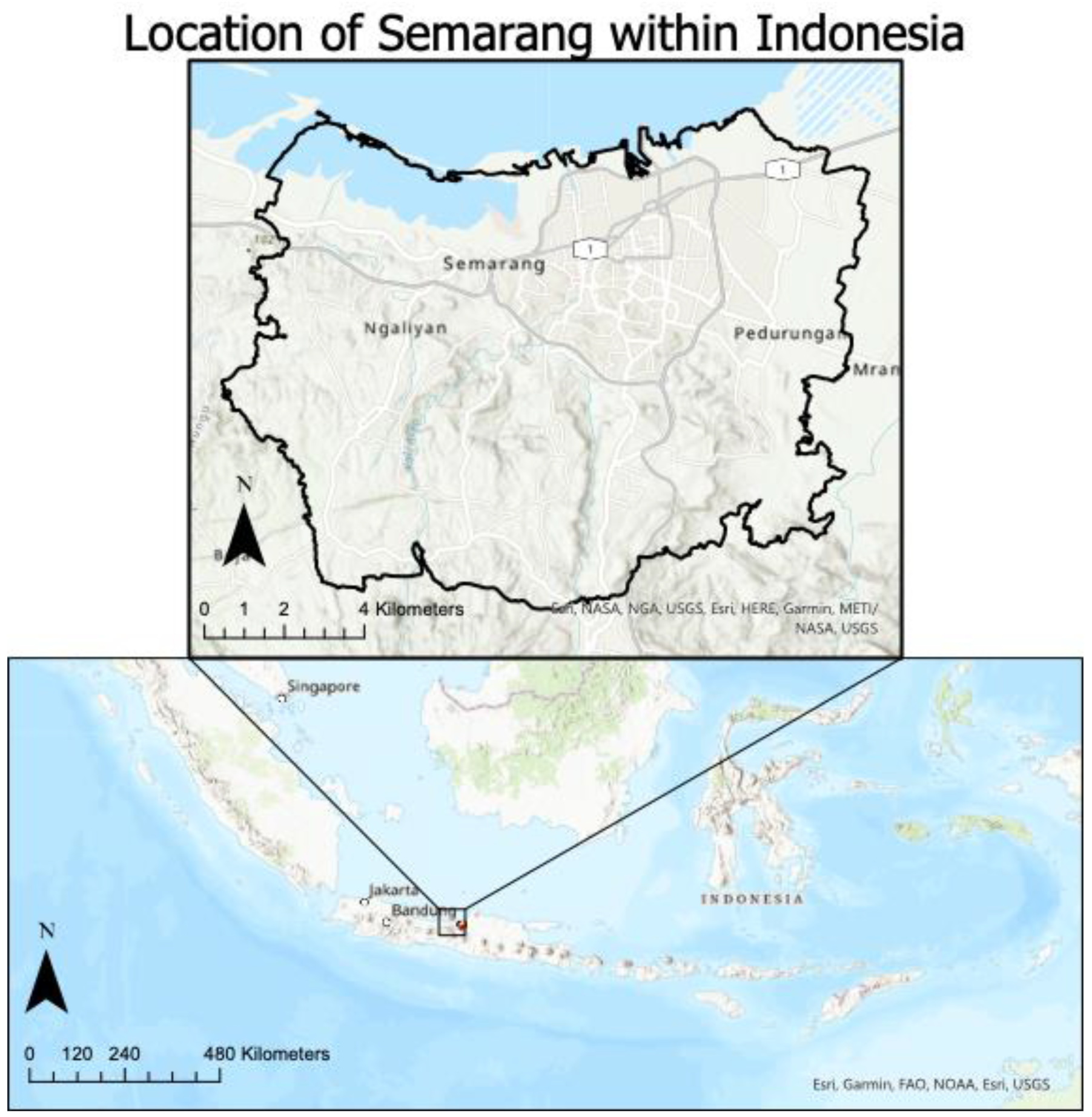
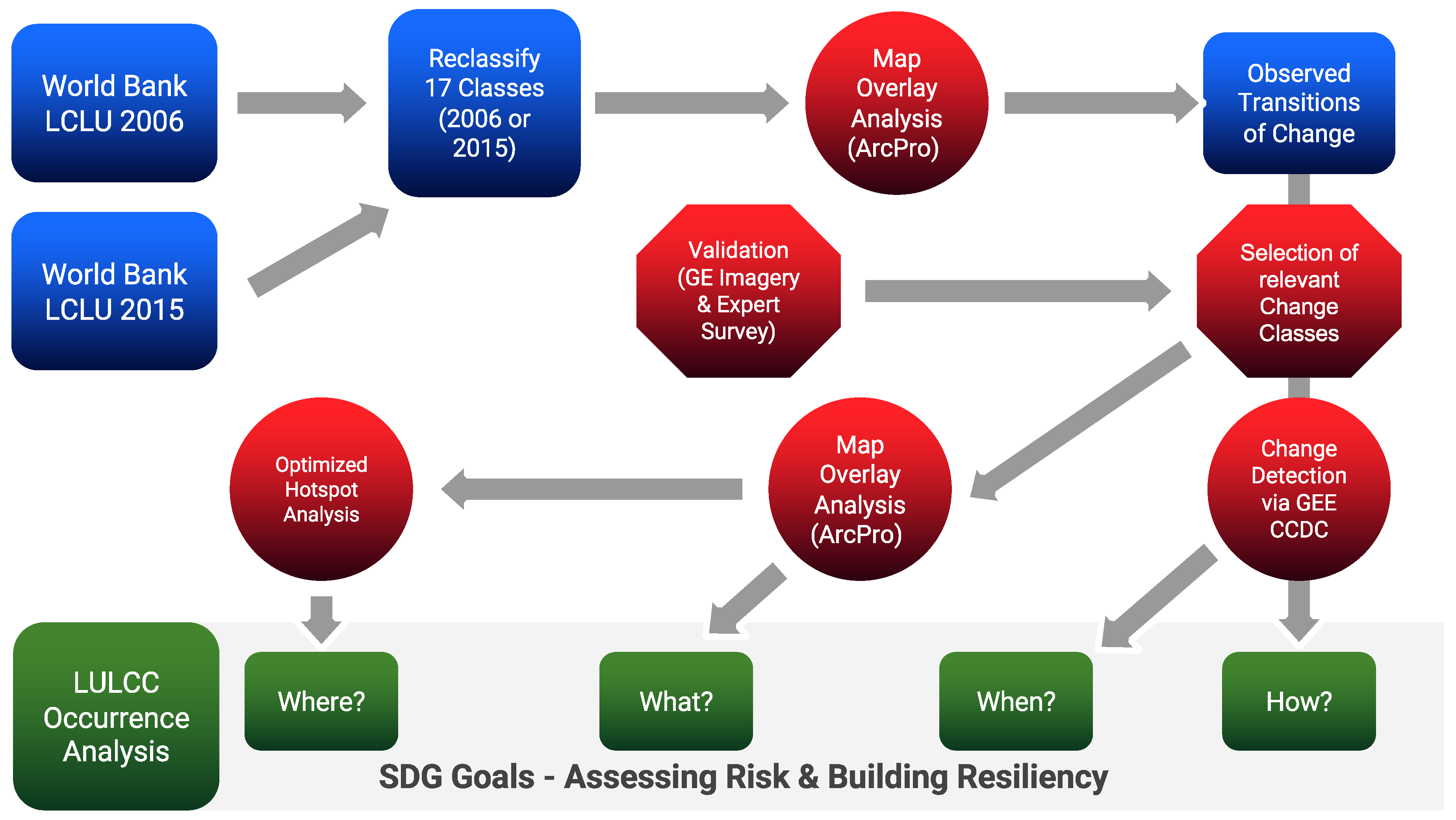

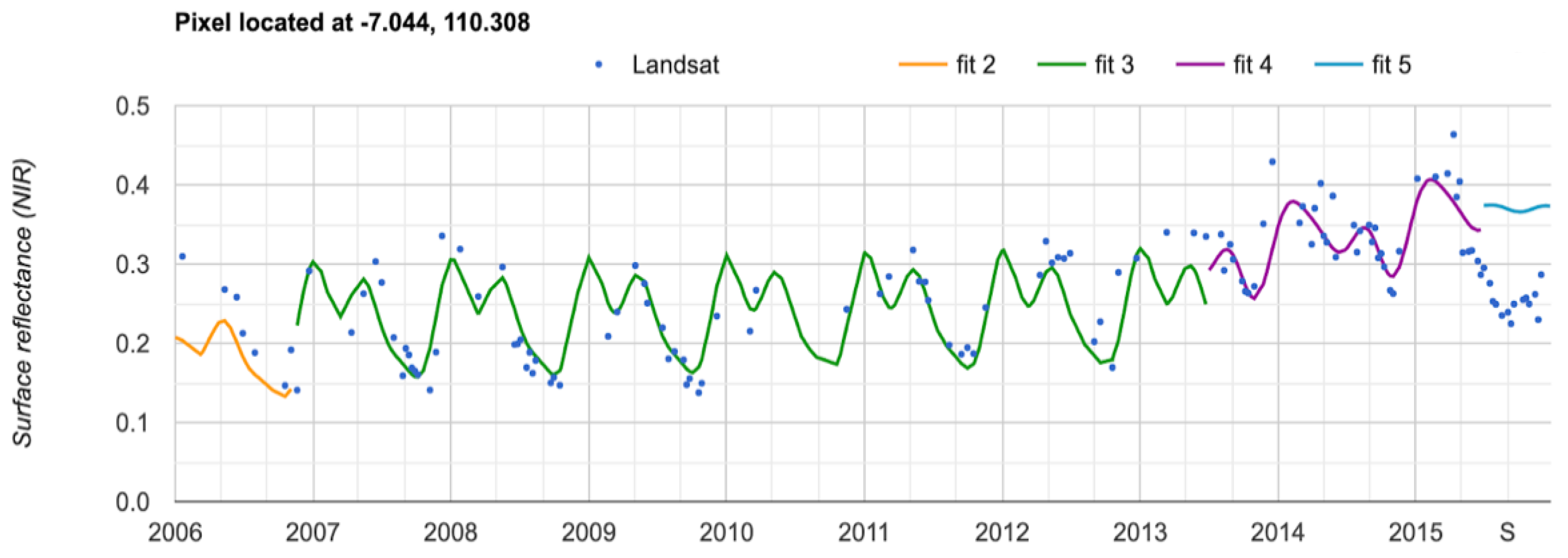

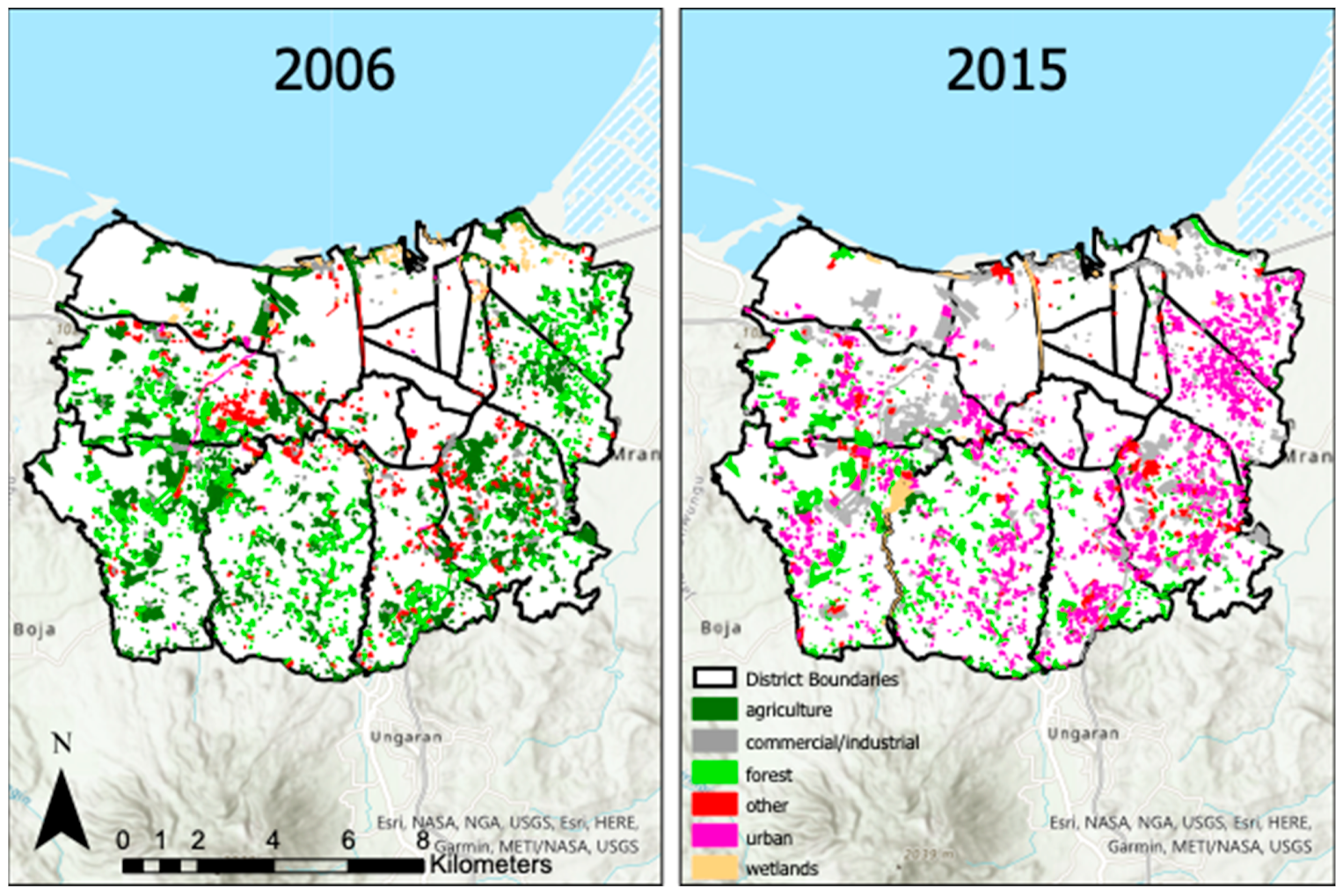

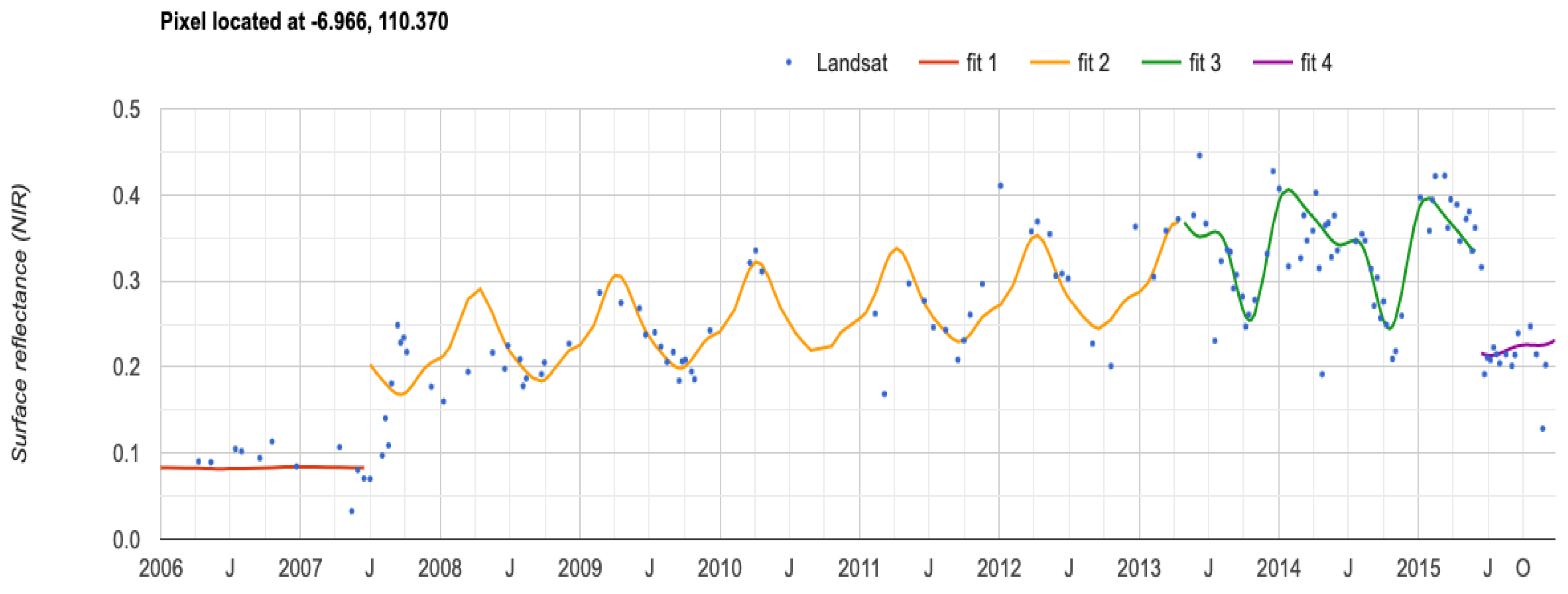
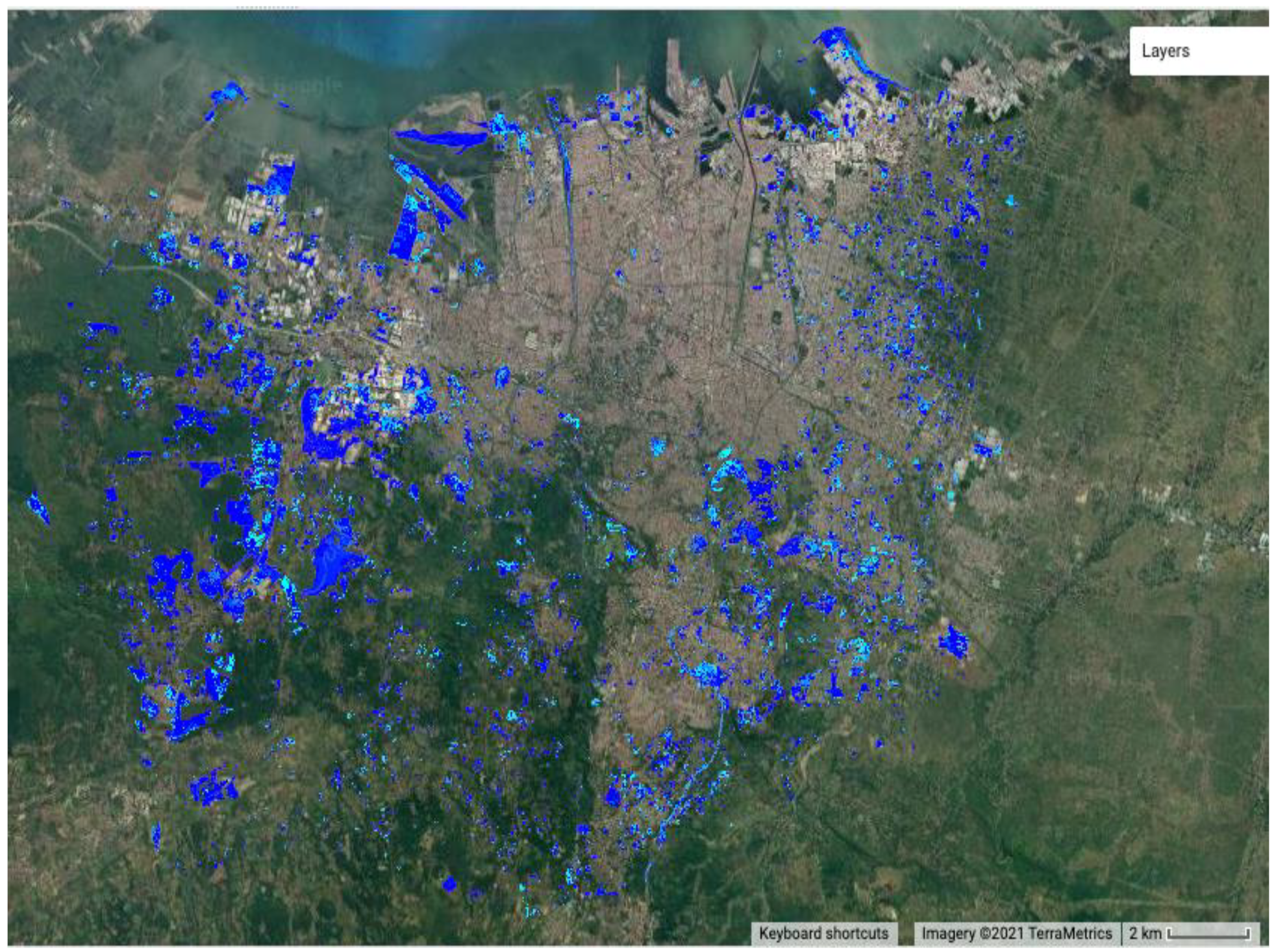
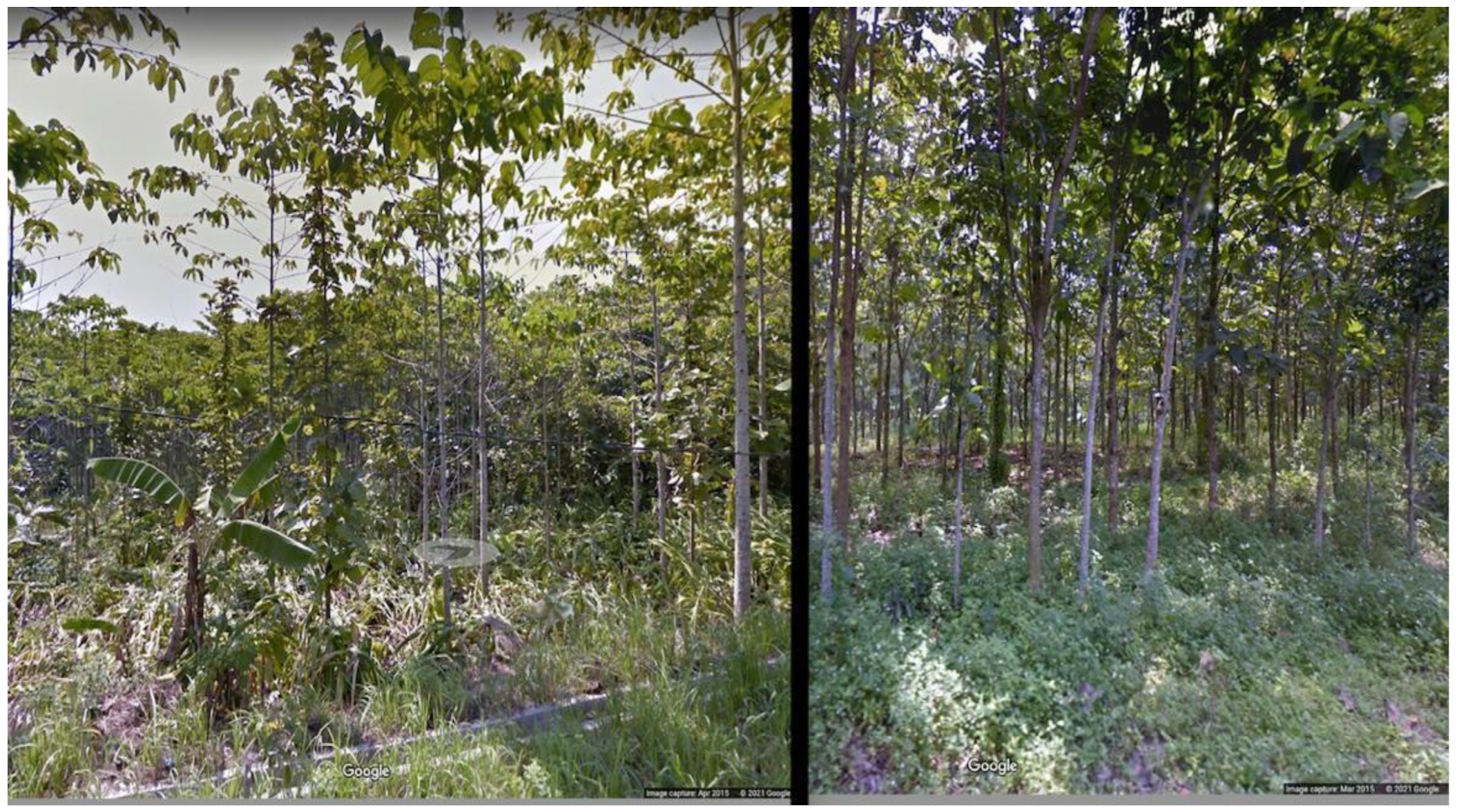
| 2015 → 2006 ↓ | Agriculture | Airport | Cemetery | Construction | Continuous Urban | Discontinuous Urban | Forest | Green Urban Area | Industrial | Inland Water | Land without Use | Mining/ Dumping | Other | Port | Recreation | Roads/Trails | Wetlands |
|---|---|---|---|---|---|---|---|---|---|---|---|---|---|---|---|---|---|
| agriculture | null | 0.841 | 0.004 | 2.683 | 0.304 | 8.319 | 10.092 | 0.774 | 3.604 | 1.485 | 1.456 | 0.495 | 1.509 | 0.000 | 0.076 | 0.133 | 0.090 |
| airport | 0.000 | null | 0.000 | 0.000 | 0.000 | 0.000 | 0.000 | 0.000 | 0.000 | 0.000 | 0.000 | 0.000 | 0.000 | 0.000 | 0.000 | 0.000 | 0.000 |
| cemetery | 0.000 | 0.000 | null | 0.000 | 0.000 | 0.540 | 0.000 | 0.013 | 0.000 | 0.000 | 0.006 | 0.000 | 0.000 | 0.000 | 0.000 | 0.001 | 0.000 |
| construction | 0.420 | 0.000 | 0.000 | null | 0.128 | 1.606 | 0.057 | 0.070 | 1.483 | 0.000 | 0.037 | 0.000 | 0.000 | 0.018 | 0.050 | 0.001 | 0.023 |
| continuous urban | 0.000 | 0.000 | 0.000 | 0.000 | null | 1.920 | 0.000 | 0.006 | 0.000 | 0.000 | 0.005 | 0.000 | 0.000 | 0.000 | 0.000 | 0.003 | 0.000 |
| discontinuous urban | 0.000 | 0.000 | 0.000 | 0.007 | 5.131 | null | 0.041 | 0.000 | 0.090 | 0.000 | 0.010 | 0.000 | 0.000 | 0.000 | 0.000 | 0.054 | 0.000 |
| forest | 2.298 | 0.000 | 0.000 | 1.108 | 0.028 | 7.809 | null | 0.370 | 1.150 | 0.142 | 0.475 | 0.075 | 0.427 | 0.000 | 0.008 | 0.205 | 0.003 |
| green urban area | 0.018 | 0.000 | 0.000 | 0.108 | 0.049 | 0.739 | 0.000 | null | 0.294 | 0.101 | 0.014 | 0.004 | 0.093 | 0.000 | 0.000 | 0.025 | 0.000 |
| industrial | 0.052 | 0.000 | 0.000 | 0.126 | 0.000 | 0.000 | 0.019 | 0.049 | null | 0.000 | 0.000 | 0.000 | 0.010 | 0.000 | 0.000 | 0.011 | 0.000 |
| inland water | 0.151 | 0.000 | 0.000 | 0.021 | 0.000 | 0.000 | 0.036 | 0.006 | 0.041 | null | 0.003 | 0.000 | 0.004 | 0.006 | 0.000 | 0.003 | 0.024 |
| land without use | 0.006 | 0.000 | 0.000 | 0.128 | 0.007 | 0.100 | 0.114 | 0.148 | 0.453 | 0.000 | null | 0.000 | 0.269 | 0.023 | 0.007 | 0.000 | 0.000 |
| mining/ dumping | 0.000 | 0.000 | 0.000 | 0.036 | 0.000 | 0.046 | 0.004 | 0.007 | 0.000 | 0.000 | 0.055 | null | 0.000 | 0.000 | 0.000 | 0.000 | 0.000 |
| other | 0.083 | 0.000 | 0.000 | 0.259 | 0.018 | 0.758 | 0.503 | 0.013 | 1.631 | 0.012 | 0.305 | 0.128 | null | 0.000 | 0.019 | 0.036 | 0.000 |
| port | 0.000 | 0.000 | 0.000 | 0.000 | 0.000 | 0.000 | 0.000 | 0.000 | 0.000 | 0.022 | 0.000 | 0.000 | 0.000 | null | 0.000 | 0.000 | 0.000 |
| recreation | 0.000 | 0.000 | 0.000 | 0.000 | 0.000 | 0.000 | 0.000 | 0.057 | 0.033 | 0.000 | 0.000 | 0.000 | 0.005 | 0.000 | null | 0.000 | 0.000 |
| roads/trails | 0.000 | 0.000 | 0.000 | 0.012 | 0.000 | 0.005 | 0.002 | 0.000 | 0.000 | 0.000 | 0.000 | 0.000 | 0.004 | 0.000 | 0.000 | null | 0.000 |
| wetlands | 0.174 | 0.000 | 0.000 | 0.026 | 0.000 | 0.055 | 0.000 | 0.004 | 0.676 | 0.148 | 0.061 | 0.000 | 0.043 | 0.014 | 0.000 | 0.008 | null |
| Original Class | Reclassification |
|---|---|
| agriculture | agriculture |
| forest | forest |
| cemetery | other(natural/semi-natural) |
| green urban area | |
| other | |
| recreation | |
| inland water | wetland |
| wetland | |
| continuous urban | urban |
| discontinuous urban | |
| construction | industrial/commercial |
| airport | |
| industrial | |
| land without use | |
| mining/dumping | |
| port | |
| roads/rails |
| 2015 → 2006 ↓ | Agriculture | Forest | Commercial/Industrial | Other | Urban | Wetland |
|---|---|---|---|---|---|---|
| agriculture | 73.04 | 10.10 | 9.22 | 2.36 | 8.63 | 1.55 |
| 18.99% | 2.63% | 2.40% | 0.61% | 2.24% | 0.40% | |
| forest | 2.22 | 80.32 | 2.97 | 0.80 | 7.84 | 0.15 |
| 0.58% | 20.88% | 0.77% | 0.21% | 2.04% | 0.04% | |
| commercial/industrial | 0.15 | 0.19 | 44.08 | 0.68 | 1.89 | 0.04 |
| 0.04% | 0.05% | 11.46% | 0.18% | 0.49% | 0.01% | |
| other | 0.10 | 0.50 | 2.85 | 10.96 | 1.71 | 0.11 |
| 0.03% | 0.13% | 0.74% | 2.85% | 0.44% | 0.03% | |
| urban | 0.00 | 0.04 | 0.17 | 0.01 | 117.24 | 0.00 |
| 0.00% | 0.01% | 0.04% | 0.00% | 30.47% | 0.00% | |
| wetland | 0.22 | 0.04 | 0.89 | 0.06 | 0.06 | 3.52 |
| 0.06% | 0.01% | 0.23% | 0.02% | 0.02% | 0.91% |
Publisher’s Note: MDPI stays neutral with regard to jurisdictional claims in published maps and institutional affiliations. |
© 2022 by the authors. Licensee MDPI, Basel, Switzerland. This article is an open access article distributed under the terms and conditions of the Creative Commons Attribution (CC BY) license (https://creativecommons.org/licenses/by/4.0/).
Share and Cite
Kelly-Fair, M.; Gopal, S.; Koch, M.; Pancasakti Kusumaningrum, H.; Helmi, M.; Khairunnisa, D.; Kaufman, L. Analysis of Land Use and Land Cover Changes through the Lens of SDGs in Semarang, Indonesia. Sustainability 2022, 14, 7592. https://doi.org/10.3390/su14137592
Kelly-Fair M, Gopal S, Koch M, Pancasakti Kusumaningrum H, Helmi M, Khairunnisa D, Kaufman L. Analysis of Land Use and Land Cover Changes through the Lens of SDGs in Semarang, Indonesia. Sustainability. 2022; 14(13):7592. https://doi.org/10.3390/su14137592
Chicago/Turabian StyleKelly-Fair, Mira, Sucharita Gopal, Magaly Koch, Hermin Pancasakti Kusumaningrum, Muhammad Helmi, Dinda Khairunnisa, and Les Kaufman. 2022. "Analysis of Land Use and Land Cover Changes through the Lens of SDGs in Semarang, Indonesia" Sustainability 14, no. 13: 7592. https://doi.org/10.3390/su14137592





